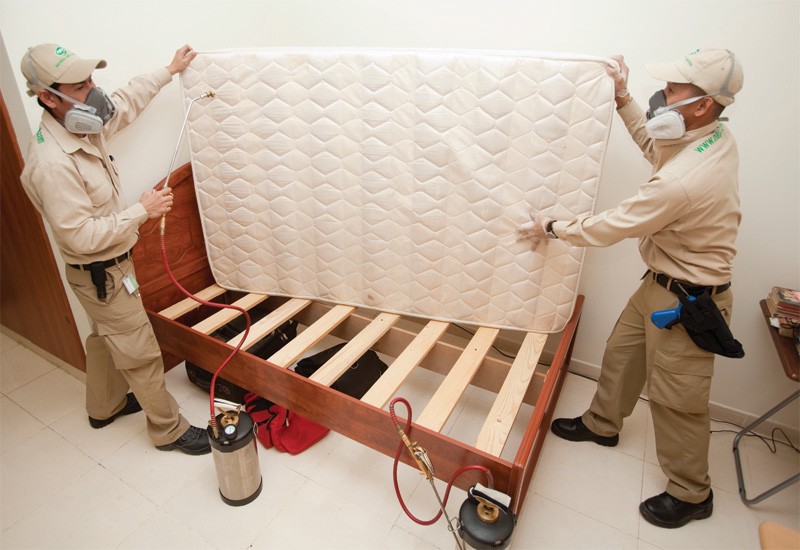Bed Bug Service Chicago: Specialist Pest Control Professionals
Bed Bug Service Chicago: Specialist Pest Control Professionals
Blog Article
Recognizing Different Treatment Choices for Bed Bug Control
In the world of pest administration, bed pests offer a special difficulty that needs a calculated and well-balanced approach for reliable control. As we browse through the subtleties of these therapy alternatives, the essential lies in picking the most ideal method that aligns with both efficiency and sustainability in bed bug control.

Chemical Treatments
Chemical treatments are an usual method used in the professional control of bed bugs. These treatments involve the application of pesticides to targeted locations where bed pests are existing. Specialists commonly use a mix of residual pesticides, which stay effective for an extended duration, and get in touch with insecticides, which act rapidly to kill bed bugs upon direct contact. The option of pesticide and application method may differ depending upon the extent of the problem, the sort of atmosphere being treated, and any possible wellness issues for passengers.
When applying chemical treatments for bed insect control, it is critical to follow all safety standards and guidelines to reduce risks to human beings, family pets, and the environment. Specialist insect control drivers are trained to select the most proper insecticides, apply them effectively, and take required preventative measures to protect against too much exposure. Furthermore, proper surveillance and follow-up examinations are important to examine the efficacy of the treatment and ensure that all bed insects have actually been removed. When made use of sensibly and in combination with various other control approaches., Chemical treatments can be an effective tool in the comprehensive monitoring of bed insect infestations.
Warm Treatments

One of the main benefits of warm therapies is that they do not involve the usage of pesticides, making them a recommended option for those worried regarding chemical exposure. In addition, heat therapies can be completed in a reasonably short duration, usually in a solitary day, reducing disturbance to the residents of the cured area.
Nonetheless, it is critical to employ the services of trained specialists when choosing warm therapies, as incorrect use of warm can position fire risks and damage home. In general, heat treatments stand for a safe, reliable, and environmentally pleasant technique to combating bed pest infestations.
Natural Treatments
When seeking alternative approaches for bed bug control, all-natural treatments offer a chemical-free strategy that can be efficient in combating infestations. These oils can be thinned down and sprayed around bed frames, walls, and other areas where bed bugs could hide. While all-natural solutions can be reliable, it's essential to note that they might require repetitive applications and thoroughness to achieve successful bed pest control.
Integrated Insect Monitoring
Taking into consideration the diverse techniques available for bed insect control, Integrated Pest Administration (IPM) stands out as a thorough approach that combines different strategies to properly resolve parasite invasions. IPM focuses on lasting prevention and monitoring of parasites with a combination of strategies such as therapy, tracking, and inspection.
One trick aspect of IPM is the emphasis on exact recognition of the parasite types and their specific actions. By understanding the biology and routines of bed insects, parasite control professionals can develop targeted strategies to eliminate invasions. Furthermore, IPM advertises using non-chemical control techniques, such as securing gaps and fractures, vacuuming, warm treatments, and using mattress encasements.
Additionally, IPM advocates for the cautious application of pesticides as a last resource, prioritizing the use of low-toxicity products and integrated methods. Routine tracking and follow-up inspections are crucial components of IPM to make certain the performance of the treatment and protect against reinfestations. Generally, Integrated Insect Management offers a holistic and lasting approach to bed bug control, advertising ecologically accountable practices while properly taking care of pest populations.
Professional Elimination Providers

Specialist pest control specialists utilize a range of methods to battle bed bug invasions, consisting of the application of pesticides, warmth treatments, vacuuming, and vapor treatments. They are equipped with the essential devices and devices to get to covert areas where bed bugs may live, such as splits, gaps, and wall surface spaces.
Additionally, expert elimination services usually involve several check outs to ensure that all best home termite treatment bed bugs and their eggs are completely gotten rid of - bed bug treatment chicago services. This comprehensive technique assists stop reinfestations and guarantees dig this lasting control of bed insects in the cured area
In addition, exterminators can provide important support on preparing the ravaged area prior to therapy and offer recommendations for preventing future bed pest infestations. On the whole, specialist elimination solutions offer a reliable and detailed service for handling bed pest invasions.
Conclusion
To conclude, different therapy alternatives for bed insect control consist of chemical treatments, warm therapies, natural treatments, incorporated bug management, and expert elimination services. Each option has its own benefits and limitations, so it is necessary to meticulously think about the details circumstances of the problem before choosing a treatment technique. Reliable bed pest control requires a detailed technique that may include a mix of these therapy alternatives to successfully eliminate the problem.
Chemical treatments can be a powerful tool in the comprehensive monitoring of bed pest infestations when utilized deliberately and in conjunction with other control techniques.
Utilized in professional bed bug control, warm squirrel removal therapies supply a non-chemical solution for getting rid of bed bug invasions properly. These oils can be weakened and splashed around bed frameworks, walls, and various other areas where bed insects might hide.In final thought, different therapy alternatives for bed bug control consist of chemical treatments, warmth therapies, all-natural solutions, incorporated pest administration, and expert extermination services. Efficient bed pest control requires a thorough strategy that may involve a combination of these treatment alternatives to efficiently eradicate the infestation.
Report this page